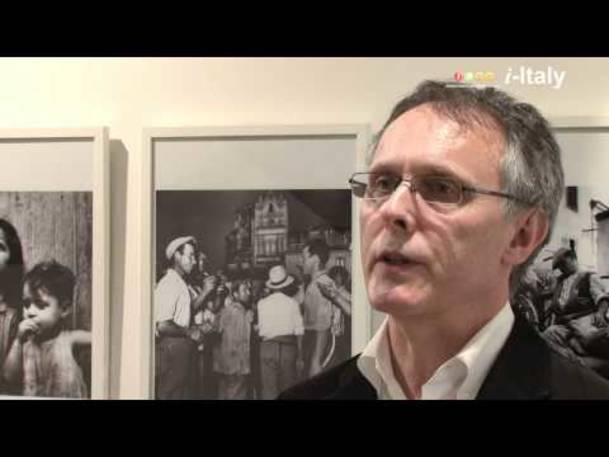


ITALY'S MARGINS: Social Exclusion in Photography and Film 1860-2010 [2], the newest exhibit hosted by NYU’s Casa Italiana Zerilli-Marimò [3] poses some interesting socio-anthropological questions.
Can the story of a country’s development be complete without the examination and exemplification of all existing social groups? Are the marginal areas of countries and cities as much real places as they are imagined or perhaps even produced to be such? Who defines these margins: their occupants or the population living outside of them? Do the examination and exhibition of, and familiarization with the marginal conditions have a positive outcome for such or do they further label it as marginal and therefore “other”?
The exhibit’s curator, David Forgacs [4], Guido and Mariuccia Zerilli-Marimò Professor in Contemporary Italian Studies at NYU tried to answer some of these questions during an Inaugural lecture held on March 5th, the opening day of the exhibition at NYU’s Casa Italiana.
During the lecture Professor Forgacs stated:
“ I am not suggesting that Italy is a pathologic country, or that it has more marginality than anywhere else, but if you want to tell the complete story of the Italian development you have to tell the story of its margins, not just the winners.” This particular exhibit focuses on Italy, but the idea can be applied to any nation in any part of the world. “I see the construction of marginality as a normal byproduct of growth of nations”- continued Forgacs.
The filled to capacity auditorium was just an initial proof of the success of this wonderful exhibit which since then had many visitors as it remains open until April 13th, 2012.
The exhibit is divided into five sections. Section I, Urban Peripheries, focuses on the living conditions of lower-class people, and includes late nineteenth-century photographs depicting a variety of social life situations as well as later images from the 1900’s which portray the living quarters of slums. Franco Ferrarotti [5]’s work from the 70’s raises the question of the importance of giving a voice to the subjects in the photographs and not just simply using them as objects of social research.
Section II, Colonies, includes photographs of the eastern and central Europe migrant population living on the peripheries of Rome as well as pictures taken in India, southern Europe, Libya and Africa, some for research purposes and others as snapshots.
Section III, Souths, centers around the idea of il Mezzogiorno [6] (the concept of a single Italian South,) which has been widely challenged by economists and historians. Found in this section amongst other works and accompanied by photographs by Arturo Zavattini [7] is the research of Ernesto De Martino [8], an ethnologist who completed a study that challenged the belief that the poor population of the South was uncultured.
Section IV, Asylums, speaks on its own presenting images of the difficulties and struggles of the mentally ill and institutionalized members of the lower class. This section has a somewhat positive message as it talks about the reform of the mental health system brought about by the work of Franco Basaglia [9] and his wife Franca Ongaro [10]. In this section the viewers will also find the photographic companion book to Basaglia’s work titled Morire di Classe [11], where the mentally ill are finally given a voice by photographers Carla Cerati [12] and Gianni Berengo [13].
Section V, Migrants, Nomads and Others addresses the issues arising from the mass immigration and the arrival of asylum seekers entering Italy in search of a better life and the avoidance of prosecution and/or war and poverty.
The extent of research and work put into this project is clearly visible. It is one of the “not to be missed” exhibitions. The director of Casa Italiana, Stefano Albertini [14]says of the exhibition: “This exhibit is truly a reflection on what is Italy when seen from its margins. It comprises of videos, photographs and written texts. It is up for another couple of weeks. Don't miss it!”
Casa Italiana once more proves to be the frontrunner in the ability to provide fascinating cultural events to the public. Its doors remain open Monday through Friday 10 am to 5 pm until April 13th.
Source URL: http://ftp.iitaly.org/magazine/events/reports/article/italys-margins-social-exclusion-in-photography-and-film-1860-2010
Links
[1] http://ftp.iitaly.org/files/italys-margins-social-exclusion-photography-and-film-1860-2010
[2] http://www.casaitaliananyu.org/content/events-0
[3] http://www.casaitaliananyu.org/
[4] http://italian.as.nyu.edu/object/faculty_italian_forgacs.html
[5] http://lnx.francoferrarotti.com/
[6] http://en.wikipedia.org/wiki/Southern_Italy
[7] http://www.imdb.com/name/nm0953789/
[8] http://en.wikipedia.org/wiki/Ernesto_de_Martino
[9] http://en.wikipedia.org/wiki/Franco_Basaglia
[10] http://it.wikipedia.org/wiki/Franca_Ongaro
[11] http://www.repubblica.it/2006/08/gallerie/spettacoliecultura/berengo-gardin/1.html
[12] http://it.wikipedia.org/wiki/Carla_Cerati
[13] http://it.wikipedia.org/wiki/Gianni_Berengo_Gardin
[14] http://italian.as.nyu.edu/object/StefanoAlbertini.html